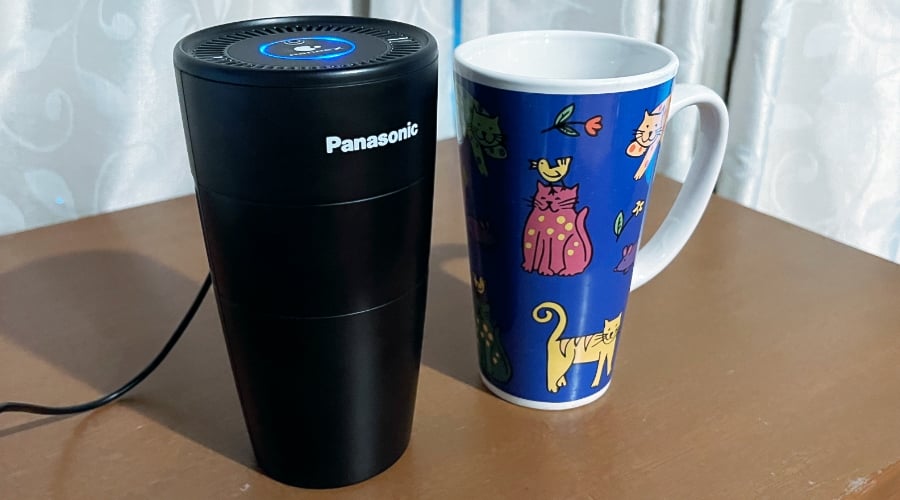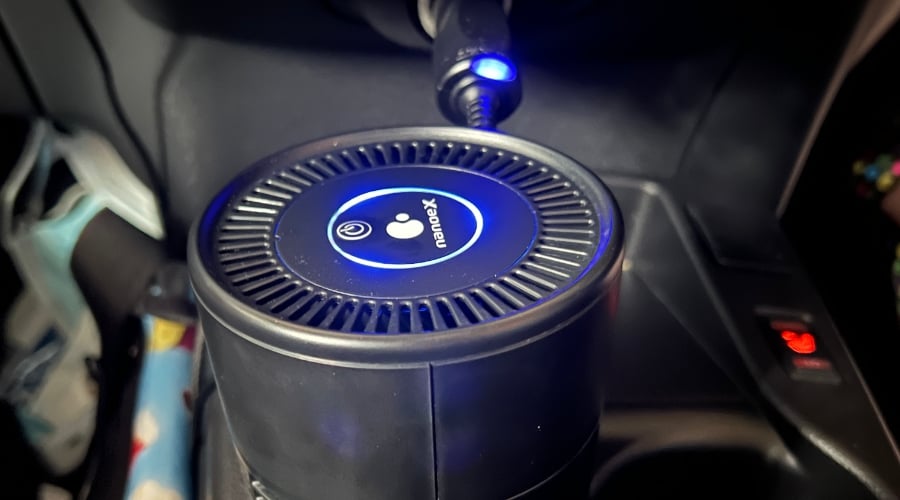Panasonic nanoeX Generator review: Solid science, but it’s not as portable as it should be
Summary
Quick verdict: Panasonic's smallest air purifier has a weird charm, but low airflow and high cost make it a less than compelling proposition.
- Science supports the idea of cleaning the air with hydroxl radicals
- Shape makes it highly portable
- 1 button, so you can't do it "wrong"
- High price
- Low essential airflow
- No internal battery
The Panasonic portable nanoeX Generator looks for all intents and purposes like a large black coffee cup. However, I've not been sipping sweet, satisfying caffeine from its darkened interior. Instead, it's a different kind of air purifier – at least in theory – that could have some significant health benefits.
Many of those benefits really are difficult for consumers to properly assess, however, so you've got to put a lot of faith in the portable nanoeX Generator if you're going to buy one. The technology and science are sound, but it's hard not to think that you'd be better off with a full nanoeX capable air conditioner. Which Panasonic also happens to sell. Funny, that.
Design: Meet the electric coffee cup. Do not add sugar

Image: Alex Kidman/Finder
Panasonic's design style for the portable nanoeX Generator borrows directly from the coffee cup industry, and that's not accidental. This is meant to be a "portable" generator, after all, and for many of us that means building it in a way so it's suitable for in-car use. Most cars have coffee cup holders, typically located near a USB power port, or for older vehicles, near the cigarette lighter that can take a USB power adaptor.

Image: Alex Kidman/Finder
It's a natural fit that works well enough, even though I was tempted to try to sip from it while it was sitting on my work desk.
At 400g, I'm sure I own coffee cups that are heavier than it is. The one downside of that light weight is that, despite its size, there's no internal battery. If you want the portable nanoeX Generator to do anything, you'll have to hook it up to external USB power every time.
The power draw of the portable nanoeX Generator isn't substantial, and it does feel like it'd be even more useful and portable if it was independently charged.
Construction is very simple, with a rear plastic filter cover that hides its USB power input, and a button at the top to switch it on or off. Unlike other air purifying solutions, there's no internal filters to replace, although you might want to dust off the power filter cover from time to time.
What the heck is a nanoeX particle, anyway?
It 100% sounds like something that a Marvel supervillain might be trying to synthesise as part of a world-conquering plot, but the reality is that it's Panasonic's marketing name for some well-established science mixed with some interesting technology.
A nanoeX particle is in effect a water molecule, but this isn't a room humidifier. Instead, each nanoeX particle has an ion and a hydroxl radical. That hydroxl radical is the key part of nanoeX technology, because they're highly reactive compounds with the potential to bond to airborne molecules of all types. You wouldn't want to breathe air that was 100% hydroxl radicals, but in this implementation, it's much more about their ability to negate particles that may contain odours, mould spores, bacteria or viruses.
In nature, hydroxl radicals don't actually last that long when they've been generated, but Panasonic's claim is that its bonding process to water – which it draws out of the ambient air, so there's no need to refill the portable nanoeX Generator – allows its nanoeX particles to live for up to 10 minutes with no risk to human health, but the potential to significantly improve air quality in our homes and offices.
Panasonic already offers nanoeX capable air conditioners, and the portable nanoeX Generator is just that technology in a smaller form factor. However, there's nothing else of an air conditioner about the portable nanoeX Generator.
Performance: Great for odour removal but it could use a stronger fan

Image: Alex Kidman/Finder
The portable nanoeX Generator is ridiculously simple to use. Hook it up to a USB power supply, which can be a power brick, portable battery or in-car USB port, press the single button on the top of the unit and you're done.
There's no fan speed, no filtering settings, nothing but a simple blue light that lets you know that power is flowing through it. I did hit some issues with getting the portable nanoeX Generator to accept power from some higher-power mobile chargers, but the odds are good that you've probably got an older, slower charger cluttering up a desk drawer somewhere. I certainly do.
The portable nanoeX Generator is not all that simple to assess, however. Because many of its claimed health benefits are more long term, and I don't quite have a spare "me" to use as a control sample, assessing its effectiveness outside a lab setting is particularly difficult.
One area I could test was in odour reduction. The nanoeX particles are meant to reduce odours notably, so I put the generator through its paces with a few simple tests. The cupboard I keep my cat food in has a distinct odour of feline comestibles, and I'm certain you're shocked by that revelation.
It's an enclosed space, so while it's not the worst smell, it is noticeable over time. I popped the portable nanoeX Generator into the cupboard hooked up to a battery pack and gave it an hour's runtime to help clear the air.
Returning to the cupboard of suspicious tuna scents revealed a much cleaner airspace. It wasn't as though I suddenly felt I was running through some fresh woodland glade, but there was an observable reduction in the quantity of fishy smells.
I could pull the same trick with a pair of sweaty sneakers and gym clothes with much the same effect. The one limiting factor here is that the nanoeX particles aren't a permanent odour remover; you'd need to keep the portable nanoeX generator running most of the time to absolutely reduce scents that way. Or in other words, I should probably clean out the cat food cupboard just a touch more regularly.
Because the nanoeX particles are suspended in tiny water particles, there's also a theoretical moisturisation benefit to having one on your desk. I can't say I've observed much difference there, but to be fair at the time of testing it's been incredibly rainy so the local atmosphere was already pretty humid. Time constraints prohibited me from trekking to the Great Sandy Desert to test its efficacy there.
The other effect that the nanoeX particles should have is to inhibit the propagation of bacteria and some virus particles. I've got to be super-careful here about exactly what's claimed, although Panasonic itself hasn't always been so circumspect. Here in Australia, its claims are light, mostly focusing on deodorisation, cleaner air and mould inhibition, with bacterial/viral loads not making its top 4 reasons to buy one.
In other markets, it's far less subtle, with this Malaysian ad bordering on the scaremongering. Seriously, Panasonic, that's not exactly comfortable advertising. Although to be clear, Panasonic's local claims are a lot more restrained in this respect.
There's an obvious problem with testing in a consumer-grade way for whether the Panasonic portable nanoeX lives up to its claims for viral protection – there's an obvious virus right now that we're all pretty wary of – and that's the fact that as much as I love my job, I'm not willing to catch COVID – or provide a "control" human with no generator – to try to assess likely impacts.
I can say that during my test period, I did not test positive for COVID, but at the same time, my lucky rock also kept me free from rampaging elephant attacks. My lucky rock didn't cost me $299.95.
Does that mean that Panasonic is selling snake oil? Not necessarily. There is a decent body of science that suggests that hydroxyl radicals may have inhibitory effects on the propagation of viruses, although what I've read (and to be fair, understood) suggests that it's more prevalent for surface-based viral loads. Current scientific thinking suggests that this is less of an issue than airborne loads of virus particles, and this is where the portable nanoeX Generator may falter.
Simply put, the fan in the portable nanoeX Generator just isn't that strong. You can tell it's running due to the noise the fan makes, and the presence of the blue light when it's on, but airflow from the top of the unit is very light indeed. On the review sample supplied by Panasonic, it only came out one side of the vent ring at all, and Panasonic tells me it's designed that way.
It's certainly not a cooling fan, and it's only going to be pushing out its particles at a relatively languid pace. Panasonic advises that it's generally good for air spaces up to 3 cubic metres, which really isn't a lot of space at all. That's fine for in-car use perhaps, but in many homes I'd worry that the effective area of impact would be lessened. Panasonic does offer the nanoeX technology in a range of its home air conditioners, and it's not hard to see those devices with their larger fans and areas of effect having a much better and more reliable result.
That's really the biggest problem with the portable nanoeX Generator. It can help with odour reduction without a doubt. It may well help with ongoing health issues, but it would need a significantly longer period of testing for reliable results here, and I do feel as though the limited fan will naturally limit quite how effective it might be. It also invites the worry that consumers might buy one feeling it made them invulnerable, and that's not going to be the story either.
Should you buy the Panasonic nanoeX Generator?
- Buy it if you spend a lot of time in smaller environments where you're worried about the air quality.
- Don't buy it if you need to clear the air in any kind of mid-sized to larger space.
The technology underlying the portable nanoeX Generator is fascinating without a doubt. If you're in the market for a full air conditioner and you're also concerned about healthy air quality – and let's face it, you should be – it's a worthwhile consideration.
At $299, the portable nanoeX Generator does feel a little pricey by comparison, and its weaker fan and small area of claimed effect are genuine issues for its overall viability. There's a good idea here, but it feels like the implementation just needs a little tweaking to be fully effective.
Pricing and availability
How we tested
The portable nanoeX Generator was not an easy product to assess under our usual criteria, because like any health product it's rather predicated on preventing issues I'd rather not subject myself to just for the sake of it.
It was tested extensively for its ability to reduce odours, as well as any perceivable effects on nearby air quality, but these were minor at best. The portable nanoeX Generator was tested in cupboards, open rooms and cars during a 1-week testing process. The model tested was supplied by Panasonic Australia for the purposes of review.

